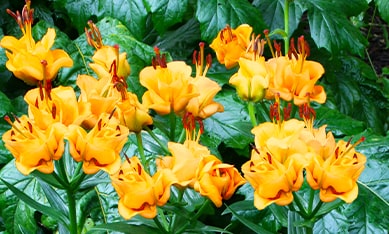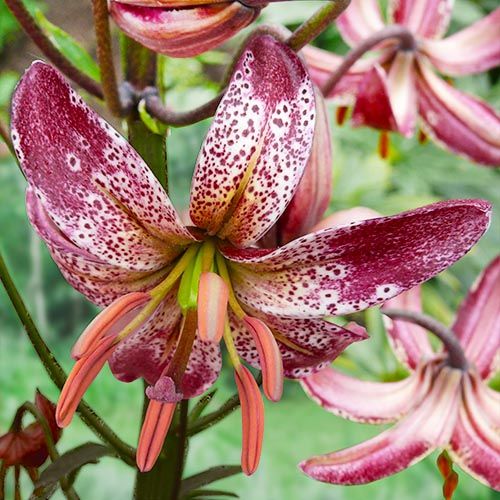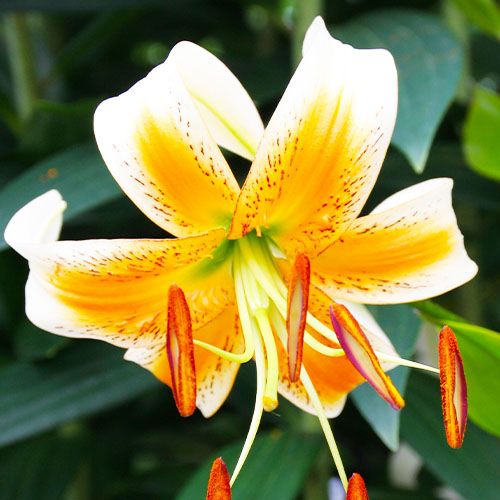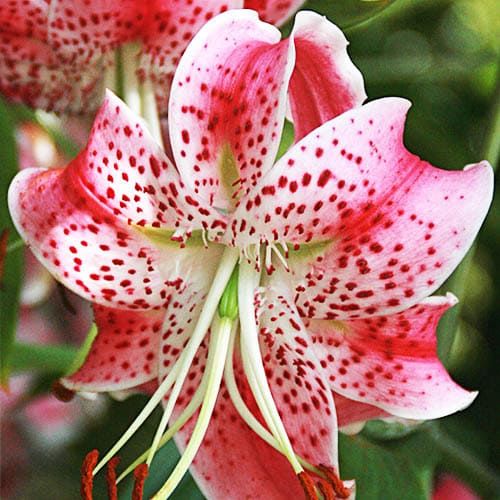Species Lilies
Species Lilies
Last Reviews
All About Lily Species: Types, Meaning, and Care Tips
A common blooming plant with several kinds, lilies each have their own distinctive traits and symbolic significance. A quick description of some of the most well-known lily species is provided below:
Asian lilies are distinguished by their vivid hues, which include orange, pink, red, and yellow. They make excellent cut flowers and are simple to cultivate.
Oriental Lilies: These lilies are available in white, pink, and burgundy hues and have a strong, sweet aroma. Compared to other lilies, they are often bigger and more spectacular.
Trumpet lilies are up to 6 feet tall and feature a trumpet-shaped bloom. They come in pink, orange, and yellow hues.
Calla Lilies: With a long, thin stalk and a large, trumpet-shaped bloom, these lilies have a distinctive form. They are available in white, pink, and yellow hues.
Daylilies: These lilies are distinguished by their vividly colored, transient blossoms. They are available in a broad spectrum of hues, including orange, yellow, red, and pink.
In terms of lily meaning, these words are often used to describe purity, innocence, and beauty. Lilies come in a variety of hues, each of which may convey a distinct message. For instance, white lilies are often connected with innocence and purity, while pink lilies stand for adoration and love.
Lilies often demand well-drained soil and plenty of sunshine when it comes to gardening. Regular watering is necessary, but avoid overwatering to prevent the bulbs from rotting. A balanced fertilizer applied in the spring and autumn may help lilies as well. To stop the spread of illness, its also crucial to remove any dead blooms and leaves.
The Meaning and Symbolism Behind Different Species of Lilies: What Do They Represent?
Different cultures and religions hold lilies in high regard. Depending on their color, shape, origin, and context, they have a variety of meanings and symbols. Here are some of the most popular ones:
- White lilies are a metaphor for virtue, chastity, innocence, and purity. They are used at weddings, funerals, and other solemn events and are frequently associated with the Virgin Mary in Christianity.
- Yellow lilies represent gratitude, friendship, joy, and happiness. They are frequently given as a token of gratitude, admiration, or sympathy.
- Pink lilies stand for admiration, femininity, grace, and elegance. Oftentimes, they are given as a sign of love, affection, or gratitude.
- Red lilies represent fervor, love, desire, and bravery. They are often given as a message of love or admiration.
- Orange lilies stand for zeal, vigor, assurance, and creativity. They are frequently given to show admiration or to encourage.
- Purple lilies symbolize spirituality, nobility, and royalty. They are frequently given as a sign of honor or respect.
- Tiger lilies represent confidence, wealth, prosperity, and pride. They are a common way to express admiration or respect.
- Calla lilies symbolize beauty, elegance, sophistication, and purity. They are often used for weddings or other formal events.
Types of Lilies Species: A Guide to Popular Varieties and Their Characteristics

There are over 100 different lily species in the world. They belong to nine main divisions based on their genetic origin and characteristics. Here are some of the most popular lily varieties in each division:
Asiatic Hybrids.
These are the earliest blooming lilies with large flowers in various colors except blue. They have no fragrance and prefer full sun to partial shade. Some examples are Connecticut King, Enchantment, Gran Paradiso, Lollypop, Orange Pixie, Tango, etc.
Martagon Hybrids.
These are also known as Turks cap lilies because of their downward-facing flowers with reflexed petals. They have a spicy fragrance and prefer partial shade to full sun. Some examples are Claude Shride, Manitoba Morning, Mrs R.O.Backhouse, Pink Morning, Sunny Morning, etc.
Candidum Hybrids.
These are also known as European or Madonna lilies because of their white trumpet-shaped flowers with yellow anthers. They have a sweet fragrance and prefer full sun to partial shade. Some examples are Candidum, June Fragrance, Snow Queen, etc.
American Hybrids.
These are also known as wild lilies because they originate from North America. They have large flowers in various colors with spots or stripes. They have a strong fragrance and prefer partial shade to full sun. Some examples are Black Beauty, Citronella, Pink Perfection, Royal Sunset, etc.
Longiflorum Hybrids.
These are also known as Easter lilies because they bloom around Easter time. They have white trumpet-shaped flowers with yellow anthers. They have a mild fragrance and prefer full sun to partial shade. Some examples are; Ace, Formia, White Heaven, etc.
Trumpet/Aurelian Hybrids.
These are also known as trumpet lilies because of their large trumpet-shaped flowers in various colors. They have a strong fragrance and prefer full sun to partial shade. Some examples are African Queen, Golden Splendor, Pink Perfection, Regale, etc.
Oriental Hybrids.
These are also known as oriental lilies because they originate from Asia. They have large flowers in various colors with spots or stripes. They have a strong fragrance and prefer partial shade to full sun. Some examples are Casa Blanca, Mona Lisa, Stargazer, Tom Pouce, etc.
Interdivisional Hybrids.
These are hybrids between different lily divisions. They have various characteristics depending on their parentage. Some examples are LA Hybrids (Asiatic x Longiflorum), OT Hybrids (Oriental x Trumpet), LO Hybrids (Longiflorum x Oriental), etc.
Species Lilies.
These are true wild lilies that have not been hybridized. They have various characteristics depending on their origin and habitat. Some examples are Lilium candidum (Madonna lily), Lilium martagon (Turks cap lily), Lilium tigrinum (Tiger lily), Lilium speciosum (Japanese lily), etc.
Asiatic vs. Oriental Lilies: Differences in Appearance, Care, and More
Asiatic and oriental lilies are two of the most popular and widely grown lilies divisions. They have many similarities but also some differences that make them suitable for different purposes and preferences. Here are some of the main differences between them:
- Appearance: Asiatic lilies have smaller flowers with upright petals in various colors except blue. Oriental lilies have larger flowers with recurved petals in various colors with spots or stripes.
- Fragrance: Asiatic lilies have no fragrance or a mild fragrance. Oriental lilies have a strong and sweet fragrance that fills a room or a garden.
- Flowering time: Asiatic lilies bloom earlier than oriental lilies, usually from late spring to early summer. Oriental lilies bloom later than asiatic lilies, usually from midsummer to late summer.
- Height: Asiatic lilies are shorter than oriental lilies, usually ranging from 1 to 4 feet tall. Oriental lilies are taller than asiatic lilies, usually ranging from 2 to 6 feet tall.
- Hardiness: Asiatic lilies are more cold-hardy than oriental lilies, usually surviving in zones 3 to 9. Oriental lilies are less cold-hardy than asiatic lilies, usually surviving in zones 5 to 9.
- Care: Asiatic lilies are easier to grow and care for than oriental lilies. They need less water and fertilizer, and they are more resistant to diseases and pests. Oriental lilies are more demanding and delicate than asiatic lilies. They need more water and fertilizer, and they are more susceptible to diseases and pests.
Planting Lily Species: How to Grow These Beautiful Blooms in Your Garden
Lily species are wonderful additions to any garden. They add color, fragrance, and elegance to your landscape, and they attract butterflies, hummingbirds, and bees. Here are some tips on how to plant and grow these beautiful blooms in your garden:
1. Choose the right location: Lily species need well-drained soil that is rich in organic matter. They also need at least 6 hours of sun per day, but some varieties prefer partial shade in hot climates.
2. Choose the right time: Lily species can be planted in spring or fall, depending on your climate and variety. Spring planting is recommended for colder regions where the ground freezes in winter. Fall planting is recommended for warmer regions where the ground does not freeze in winter.
3. Prepare the soil: Lily species need loose and fertile soil that allows their roots to spread easily. You can improve your soil by adding compost, manure, or peat moss before planting. You can also add some bone meal or slow-release fertilizer to provide nutrients for your plants.
4. Plant the bulbs: Lily species bulbs should be planted at a depth of about three times their height and spaced about 8 to 12 inches apart. You can dig individual holes or make a trench for multiple bulbs. Make sure the pointed end of the bulb is facing up and cover it with soil.
5. Water and mulch: Lily species need regular watering during their growing season, especially in dry or hot weather. You can water them once or twice a week, depending on the soil moisture and rainfall. You can also mulch around the plants with organic material such as straw, bark, or leaves to conserve moisture and prevent weeds.
6. Steak and deadhead: Lily species may need staking to support their tall stems and heavy flowers. You can use bamboo stakes, metal rods, or wooden sticks to tie the stems to. You can also deadhead the faded flowers to encourage more blooming and prevent seed formation.
When Do Lily Species Bloom? A Seasonal Guide to Flowering Times

Lily species have different blooming times depending on their division and variety. Here is a general guide to when you can expect to see these gorgeous flowers in your garden:
Spring
The earliest blooming lilies are the asiatic hybrids and the candidum hybrids. They usually start flowering in late spring and last until early summer. Some examples are Connecticut King, Enchantment, Candidum, June Fragrance;, etc.
Early summer
The next blooming lilies are the martagon hybrids and the longiflorum hybrids. They usually start flowering in early summer and last until midsummer. Some examples are Claude Shride, Manitoba Morning, Ace, Formia, etc.
Midsummer
The peak blooming lilies are the trumpet/aurelian hybrids and the oriental hybrids. They usually start flowering in midsummer and last until late summer. Some examples are African Queen, Golden Splendor, Casa Blanca, Stargazer, etc.
Late summer
The last blooming lilies are the american hybrids and some of the interdivisional hybrids. They usually start flowering in late summer and last until early fall. Some examples are Black Beauty, Citronella, LA Hybrids, OT Hybrids, etc.
Are Lily Species Deer Resistant? Tips for Protecting Your Garden
Lily species are unfortunately not deer resistant. Deer love to munch on these tasty flowers and leaves, especially in spring when they are hungry and new growth is emerging. Here are some tips on how to protect your garden from these unwanted visitors:
1. Fence: The most effective way to keep deer away from your lilies is to fence your garden with a sturdy and tall barrier. You can use wire mesh, wood, or metal to create a fence that is at least 8 feet high and has no gaps or openings.
2. Repellent: Another way to deter deer from your lilies is to use repellents that have unpleasant smells or tastes for them. You can use commercial products that contain ingredients such as garlic, pepper, eggs, soap, or blood meal. You can also make your own repellents with natural materials such as vinegar, hot sauce, or hair clippings. You need to apply repellents regularly and after rain or irrigation.
3. Scare: Another way to scare deer away from your lilies is to use devices that make noise or motion when they sense movement. You can use wind chimes, bells, whistles, radios, sprinklers, or lights to create a disturbance that will spook the deer. You need to change the location and type of devices frequently to prevent deer from getting used to them.
4. Plant: Another way to discourage deer from your lilies is to plant other plants that they dislike or avoid around them. You can use plants that have strong smells or tastes such as lavender, rosemary, mint, sage, thyme, marigolds, daffodils, alliums, etc.
Lily Species Bulbs: How to Store and Replant for Year-Round Blooms
Lily species bulbs are perennial plants that can be stored and replanted for year-round blooms. Here are some steps on how to do it:
- After the foliage has died back in fall or winter, you can dig up the bulbs carefully with a spade or fork. You need to loosen the soil around them and lift them gently without damaging them.
- After you have dug up the bulbs, you need to clean them by removing any soil, roots, stems, or leaves attached to them. You can use a soft brush or cloth to wipe them gently.
- After you have cleaned the bulbs, you need to cure them by letting them dry in a cool and airy place for a few days. This will help them harden and heal any wounds or cuts.
- After you have cured the bulbs, you need to store them in a cool and dry place until you are ready to replant them. You can use paper bags, cardboard boxes, or mesh baskets to store them. You can also add some peat moss, vermiculite, or sawdust to keep them from drying out or rotting. You need to check them periodically and remove any damaged or diseased bulbs.
- When you are ready to replant the bulbs, you need to follow the same steps as planting new bulbs. You need to choose the right location, time, soil, depth, spacing, water, and mulch for your lily species. You can also add some fertilizer or bone meal to boost their growth and flowering.
Frequently asked questions about Spring Flowering Species Lilies
Which lily species are available in your online flower and plant shop?
In our online store we offer a variety of lily species, including Asian lilies, oriental lilies, trumpet lilies and many other varieties. You can view the available types and varieties in our product list.
When is the best time to plant Danish lily bulbs?
The best time to plant lily bulbs is in autumn or spring. In most regions, planting should take place about 6-8 weeks before the first frost to ensure that the bulbs can form enough roots before winter arrives.
What care do lily bulbs need?
Lily bulbs need good drainage, full sun or partial shade and regular watering. Make sure the soil is well drained and the plants get enough water. Lilies also need regular fertilization to grow and bloom healthy.
Can I buy Dutch lily bulbs all year round?
Our online flower and plant shop offers lily bulbs depending on the season. Availability may vary depending on the time of year and variety. We recommend visiting our website regularly or signing up for our newsletter to be informed about current offers and availability.
How are the lily bulbs delivered?
We deliver our lily bulbs carefully packed and well protected to ensure they arrive at your place in the best condition. The exact details of delivery, shipping costs and delivery times can be found in our shipping guidelines on our website.

















